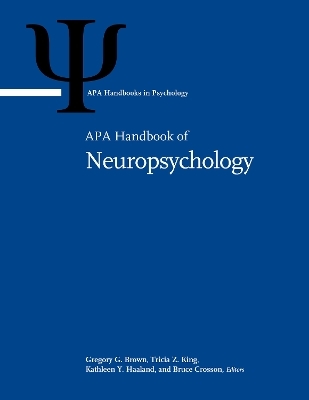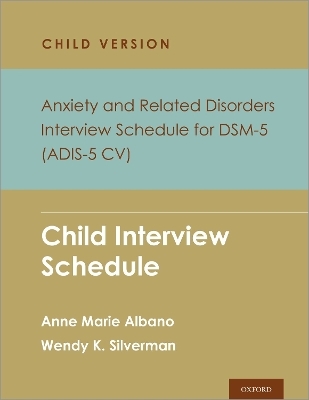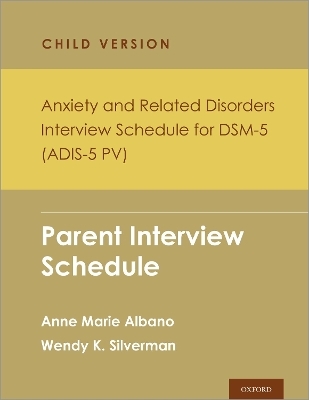
APA Handbook of Neuropsychology
American Psychological Association
978-1-4338-4000-5 (ISBN)
Broad coverage areas include neurobehavioral disorders; clinical conditions; neuroscience; methods of assessment; rehabilitative, medical, and surgical interventions; neuroimaging methods; and statistical and probabilistic models for neuropsychologists.
Gregory G. Brown, PhD, ABPP-CN, is emeritus professor, Department of Psychiatry, University of California, San Diego School of Medicine. Dr. Brown earned a PhD in psychology from Wayne State University in 1977. He worked as a clinical neuropsychologist at Henry Ford Hospital in Detroit, Michigan for 17 years and at The New York Hospital/Cornell University Medical College for a year. In 1995, he joined the Department of Psychiatry at University of California, San Diego, and the Psychology Department at the VA San Diego Healthcare System. Throughout his career he has taught courses on clinical neuropsychology and mentored trainees. Dr. Brown has 170 papers listed in ResearchGate; his neuropsychological research has been wide-ranging, involving studies of the neuropsychological functioning of patients with neurological or neuromedical disorders and studies of these patients using functional and structural brain imaging. He has a board certification from the American Board of Professional Psychology with a specialty in clinical neuropsychology, and is a fellow of Division 40 of the American Psychological Association (Society for Clinical Neuropsychology). He was the editor of the APA’s journal Neuropsychology from 2014 to 2019. Bruce Crosson, PhD, ABPP-CN, has published more than 150 refereed journal articles during a career of over 40 years, and mentored 26 faculty, fellows, and graduate students. Most recently, Dr. Crosson’s primary faculty affiliations have included professor of clinical and health psychology at the University of Florida (1989–2012) and professor of neurology and of radiology and imaging sciences at Emory University (2012–2021). He held an honorary professorship in health and rehabilitation sciences at the University of Queensland in Brisbane, Australia for 18 years (2004–2021). Dr. Crosson was the recipient of a Senior Research Career Scientist Award from the VA Rehabilitation Research and Development Service (2009-2021). He is considered one of the world’s leading experts on subcortical functions in language and is also recognized for his expertise in functional neuroimaging. Dr. Crosson has held a diplomate in clinical neuropsychology from the American Board of Professional Psychology since 1986, and he is a fellow of the American Psychological Association. He was one of the organizers of the 1997 Houston Conference on Specialty Education and Training in Clinical Neuropsychology, which has guided the training of clinical neuropsychologists for more than 20 years. Kathleen (Kathy) Y. Haaland, PhD, ABPP-CN, is a tenured professor of psychiatry and behavioral sciences at the University of New Mexico Health Sciences Center. She is board certified by the American Board of Professional Psychology and the American Board of Clinical Neuropsychology (ABPP-CN) where she continues to participate in board certification exams. She has published more than 100 papers and chapters largely focused on the cognitive and neuroanatomical correlates of action in stroke, Parkinson’s disease, and Huntington’s disease. Her research was continuously funded from 1981 to 2014, and in addition to serving as the director of neuropsychology at the New Mexico VA Healthcare System for many years, she was a VA research career scientist from 2004 to 2014. She has been recognized locally for her research, is a fellow of the American Psychological Association, and received lifetime career contribution awards from the International Neuropsychological Society and the National Academy of Neuropsychology. She has also served in leadership roles in the International Neuropsychological Society, the APA, and the American Board of Clinical Neuropsychology. She was the symposium editor and then editor in chief of the Journal of the International Neuropsychological Society. Since 2017 she has been an associate editor for the neuroscience section of Frontiers for Young Minds. Tricia Z. King, PhD, is a tenured professor in the Department of Psychology at Georgia State University (GSU). She is a fellow of Division 40 of the American Psychological Association (Society for Clinical Neuropsychology). Dr. King earned her PhD in clinical psychology with a neuropsychology specialization at the University of Florida. Dr. King continues to investigate the interacting biopsychosocial factors that contribute to optimal outcomes following neurodevelopmental disruption. The overarching goal of her work is to contribute to advancements in precision medicine, resulting in greater prognostic abilities and enhanced interventions to mitigate neurotoxicity and enable individuals to thrive. She has published more than 100 peer reviewed papers and chapters. Dr. King is committed to diversifying the trainee pipeline and has enjoyed mentoring and training at the undergraduate and graduate level. She sponsors a chapter of the Association of Students and Trainees at GSU (SCN ANST) and was awarded the GSU Outstanding Undergraduate Mentoring Award. She has served as the chair of the SCN Scientific Advisory Board, member of the SCN Fellows Committee, and was elected Treasurer of SCN. Dr. King serves on the editorial board for Child Neuropsychology and is an associate editor of The Clinical Neuropsychologist.
Volume 1.Neurobehavioral Disorders and Conditions: Accepted Science and Open Questions
Contents
Editorial Board
About the Editors
Contributors
A Note from the Publisher
Introduction
Chapter 1. Clinical Neuropsychology: Foundational History and Future Prospects
Gregory G. Brown and Kenneth M. Adams
Part I. Neurobehavioral Disorders
Chapter 2. Word Finding and Lexical Semantic Disorders
Anastasia M. Raymer
Chapter 3. Discourse and Communicative Pragmatics
Seana Coulson, Jacob Momsen, and Crystal R. Poole
Chapter 4. The Neuropsychology of Mathematical Cognition
Konstantinos Priftis
Chapter 5. Specific Reading Disabilities
Jeremy Miciak and Jack M. Fletcher
Chapter 6. Body Representation Disorders
Liana Palermo and Antonella Di Vita
Chapter 7. Higher Order Visual Disorders
Ransom W. Campbell and Daniel Tranel
Chapter 8. Syndromes of Limb Apraxia: Developmental and Acquired Disorders of Skilled Movements
Jennifer Randerath
Chapter 9. Disorders of Executive Functioning
Yana Suchy
Chapter 10. Memory Disorders
Mieke Verfaellie and Margaret M. Keane
Part II. Clinical Conditions
Chapter 11. Spina Bifida and Other Neural Tube Defects
Victoria J. Williams, Amery Treble-Barna, Ashley L. Ware, and Jack M. Fletcher
Chapter 12. Very Preterm Birth
Alice C. Burnett
Chapter 13. Cerebral Palsy
Seth Warschausky
Chapter 14. Pediatric Brain Tumors
Michelle E. Fox and Tricia Z. King
Chapter 15. Neuropsychological Outcomes in Phenylketonuria
Cristina Romani, Lucie Thomas, and Stephan Huijbregts
Chapter 16. Neuropsychology of ADHD
Erik G. Willcutt
Chapter 17. Epilepsy and Neuropsychology
Bruce P. Hermann, David W. Loring, Stephen C. Bowden, and Rani Sarkis
Chapter 18. Traumatic Brain Injury
Andrew R. Mayer, Lindsay D. Nelson, and Erin D. Bigler
Chapter 19. Leukemia and Sickle Cell Disease
Kristina K. Hardy, Christina M. Sharkey, Hannah Weisman, and Steven Hardy
Chapter 20. Vascular Disease including Vascular Dementia
Daniel A. Nation
Chapter 21. Infectious Disorders: HIV, Hepatitis C, and COVID-19 Pandemics
Mariana Cherner, Rowan Saloner, Erin Sundermann, and David Moore
Chapter 22. Frontotemporal Dementia
Molly Memel, Joel H. Kramer, and Doris Chen
Chapter 23. Alzheimer’s Disease
Katherine J. Bangen, Lisa V. Graves, Emily C. Edmonds, Kelsey R. Thomas, and Mark W. Bondi
Chapter 24. Parkinson’s Disease and Parkinsonism: What the Field Knows
Alexander I. TrÖster
Chapter 25. Huntington's Disease Across the Lifespan
Julie C. Stout
Chapter 26. Multiple Sclerosis
Michelle H. Chen, Ralph H. B. Benedict, and John DeLuca
Chapter 27. Alcohol Drinking and Alcohol Use Disorder Across the Ages: Dynamic Effects on the Brain and Function
Edith V. Sullivan, SÉverine Lannoy, Anne-Pascale Le Berre, Rosemary Fama, and Adolf Pfefferbaum
Chapter 28. Neurocognitive Correlates of Psychostimulant Use
Gill Bedi, Candice Basterfield, Alex A. Guerin, Eddie Mullen, Robert Hester, and Stephen C. Bowden
Chapter 29. Marijuana
Natania A. Crane and Natasha E. Wade
Chapter 30. Prenatal Exposure to Opioids
Egil Nygaard and Jannike MØrch Andersen
Chapter 31. Environmental Toxicities Including Lead
Roberta F. White and Aaron S. Reuben
Chapter 32. Sleep and Circadian Rhythm Disorders
Sean P. A. Drummond, Melinda L. Jackson, and Jade M. Murray
Chapter 33. Autism Spectrum Disorder
Rebecca P. Thomas, Kirsty L. Coulter, and Deborah A. Fein
Chapter 34. Schizophrenia
Amy M. Jimenez and Michael F. Greene
Chapter 35. The Neuropsychology of Mood Disorders
Federica Klaus and Lisa T. Eyler
Chapter 36. The Neuropsychology of Anxiety: An Approach-Avoidance Decision-Making Framework
Robin L. Aupperle, Timothy J. McDermott, Evan White, and Namik Kirlic
Chapter 37. Eating Disorders: Anorexia Nervosa, Bulimia Nervosa, and Binge Eating Disorder
Christina E. Wierenga
Index
Volume 2. Neuroscience and Neuromethods
Contents
Editorial Board
Contributors
Part I. Neuroscience
Chapter 1. Brain Organization: From Cells and Circuits to Systems and Networks
Alex Fornito
Chapter 2. Brain Development
ClareE. Palmer and Terry L. Jernigan
Chapter 3. Behavior Genetics in Neuropsychology
William S. Kremen, Eero Vuoksimaa, and Chandra A. Reynolds
Chapter 4. Learning and Memory
Alexander J. Barnett and Charan Ranganath
Chapter 5. Movement
Brian P. Johnson and Leonardo G. Cohen
Chapter 6. Higher-Order Visual Object Representations: Functional Analysis of Their Role in Perception and Action
Bradford Z. Mahon
Chapter 7. The Neuroscience of Language and Aphasia
Nina F. Dronkers and Maria V. Ivanova
Chapter 8. Neuroscience of Executive Functioning
Yana Suchy
Chapter 9. Social Neuroscience
Marie-Pier B. Tremblay, Carola Tuerk, Philip L. Jackson, and Miriam H. Beauchamp
Part II. Assessment: Emerging Methods
Chapter 10. Centering Social Forces and Cultural Experiences in Neuropsychological Assessment
Miguel Arce RenterÍa, Justina F. Avila, Jet M. J. Vonk, and Jennifer J. Manly
Chapter 11. Automated Neuropsychological Testing
Russell M. Bauer and Robert M. Bilder
Chapter 12. Wearable and Digital Technology Tools: Neuropsychological Assessment, Monitoring and Diagnosis in the Digital Era
Rhoda Au, Honghuang Lin, Kieffer Christianson, and Daniela Brunner
Chapter 13. Assessing and Predicting Everyday Function
Tania Giovannetti, Katherine Hackett, Molly B. Tassoni, Rachel Mis, and Stephanie M. Simone
Chapter 14. Evaluating social cognition
Skye McDonald and Michelle Kelly
Chapter 15. Videoconference Teleneuropsychology
Travis H. Turner and Timothy W. Brearly
Part III. Interventions
Chapter 16. Rehabilitation of Neuropsychological Deficits: The Role of Restorative Approaches
Thomas F. Bergquist, Molly J. Sullan, and Eva C. Alden
Chapter 17. Rehabilitation of Neuropsychological Deficits: Compensatory Approaches
Alyssa Weakley and Sarah Tomaszewski Farias
Chapter 18. Pediatric Rehabilitation
Shari L. Wade, Lisa M. Gies, Anna R. Adlam, Alessandra Bardoni, Claudia Corti, Kelly M. Jones, Jennifer Limond, and Tricia Williams
Chapter 19. Aphasia Treatment: Lessons for Clinically Oriented Neuroscientists
Bruce A. Crosson
Chapter 20. Interventions for Psychosocial and Emotional Sequelae of Brain Injury and Disease
Skye McDonald, Tamara Ownsworth, and Dana Wong
Chapter 21. From Virtual Reality to Augmentative Apps: The Future of Cognitive Rehabilitation Therapeutics
Anthony Y. Stringer and Anastacia Nichols
Chapter 22. Non-Invasive Brain Stimulation as a Rehabilitation Tool for Cognitive Impairment: Current Evidence, Clinical Implications, and Future Directions
Benjamin M. Hampstead, Ketrin Lengu, Elana R. Goldenkoff, and Michael Vesia
Chapter 23. Clinical Virtual Reality: The State of the Science
Albert Rizzo, Sebastian Koenig, Belinda Lange
Chapter 24. Life Style Interventions
Joe R. Nocera, Keith M. McGregor, and Monica C. Serra
Chapter 25. Implementation Science
Christopher J. Miller and Julianne E. Brady
Part IV. Neuroimaging Methods: Tutorial Presentations
Chapter 26. Structural MRI
Amanda Bischoff-Grethe and Christine Fennema-Notestine
Chapter 27. Functional and Physiological Magnetic Resonance Imaging
Frank Haist, Divya S. Bolar, and Richard B. Buxton
Chapter 28. Diffusion Imaging and Fiber Mapping
Erin D. Bigler and Naomi J. Goodrich-Hunsaker
Chapter 29. Electroencephalography in Infants and Children
Michelle Downes, Joe Bathelt, and Wanze Xie
Chapter 30. Magnetoencephalography
Carly Demopoulos
Chapter 31. PET Neuroimaging of Neurologic Disease: Methods, Clinical and Research Applications
Keenan A. Walker and Murat Bilgel
Part V. Statistical and Probabilistic Models for Neuropsychologists
Chapter 32. Formal Models of Cognition and Behavior
Gregory G. Brown
Chapter 33. Advances in Psychometric Theory: Item Response Theory, Generalizability Theory, and Cognitive Psychometrics
Michael L. Thomas and John R. Duffy
Chapter 34. Structural Equation Modeling in Neuropsychology Research
Rex B. Kline
Chapter 35. Multilevel Modeling in Neuropsychological Research
Ronald H. Heck and Tingting Reid
Chapter 36. Machine Learning
Daoqiang Zhang, Mingxia Liu, Wei Shao, Jiashuang Huang, Mingliang Wang, Liang Sun, and Meiling Wang
Index
| Erscheint lt. Verlag | 31.7.2023 |
|---|---|
| Reihe/Serie | APA Handbooks in Psychology® Series |
| Zusatzinfo | 131 figures, 65 tables, 189 exhibits |
| Verlagsort | Washington DC |
| Sprache | englisch |
| Maße | 216 x 279 mm |
| Themenwelt | Geisteswissenschaften ► Psychologie ► Biopsychologie / Neurowissenschaften |
| ISBN-10 | 1-4338-4000-6 / 1433840006 |
| ISBN-13 | 978-1-4338-4000-5 / 9781433840005 |
| Zustand | Neuware |
| Haben Sie eine Frage zum Produkt? |
aus dem Bereich


